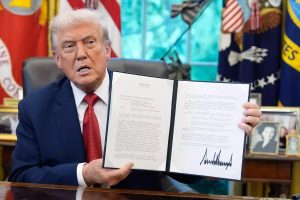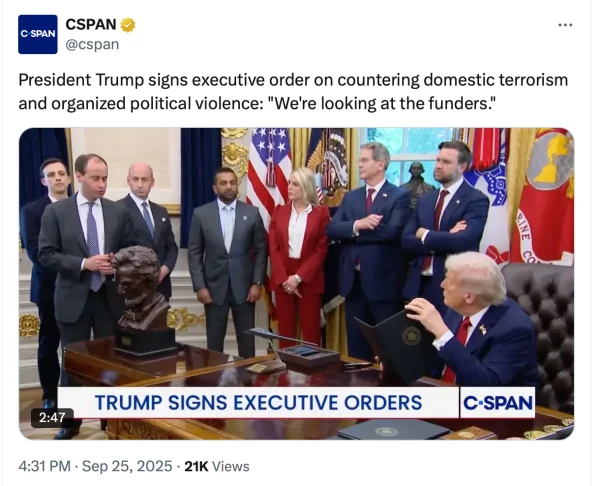Cyber Security News Aggregator
.Cyber Tzar
provide acyber security risk management
platform; including automated penetration tests and risk assesments culminating in a "cyber risk score" out of 1,000, just like a credit score.Trump’s NSPM-7 Criminalizes Common Beliefs as Terrorism Signs
published on 2025-09-28 15:25:26 UTC by Snutz37Content:

As the mainstream media focused on the TV-ready spectacle of James Comey’s indictment, Trump has signed a largely overlookednational security directivelabeling “anti-Christian” and “anti-American” perspectives as signs of radical left-wing violence. Known as National Security Presidential Memorandum 7, it is being called “NSPM-7” by officials within the administration.
“This marks the first instance in U.S. history where there has been a comprehensive government initiative aimed at dismantling left-wing terrorism,” said Stephen Miller, the homeland security advisor to Trump, referring to the announcement.
To the extent that major media covered the directive, they (including C-SPAN!) mistakenly referred to it as an “executive order,” similar to this week’sdesignationregarding “Antifa” as a domestic terrorist group.

It’s difficult to exaggerate how distinct NSPM-7 is from the more than 200 executive orders Trump has rapidly issued since returning to office.
An executive order outlines the daily operations of the federal government; whereas a national security directive is a broad policy statement concerning defense, foreign affairs, intelligence, and law enforcement. National security directives are typically confidential, but in this instance, the Trump administration decided to release NSPM-7 — the seventh such document since his arrival in office.
Previous national security policies have been contentious, even politically transformative. In 1980, for instance, President Jimmy Carter issued the Top SecretPresidential Directive 59(“PD-59”) introducing new nuclear warfare strategies that remained in effect until the conclusion of the Cold War. Upon its disclosure, PD-59 sparked widespread public outrage.
In a similar manner, President George W. Bush issued several classified national security directives following the 9/11 attacks, with the most well-known one granting the NSA authority to conduct illegal domestic surveillance, a fact that remained undisclosed to the public for four years.
In NSPM-7, “Combating Domestic Terrorism and Organized Political Violence,” President TrumpdirectsThe Justice Department, the FBI, and other national security agencies and departments were directed to combat what he considered political violence in America, by reorganizing a system of Joint Terrorism Task Forces to concentrate on “leftist” political violence. This extensive counterterrorism force, consisting of federal, state, and local agents, would, as Trump advisor Stephen Miller stated, serve as “the central hub of that effort.”
NSPM-7 introduces a new national approach aimed at “disrupting” any person or organizations that “incite political violence,” including “before they lead to violent political actions.”
In other words, they are focusing on pre-crime, to referenceMinority Report.
The Trump administration is not solely focusing on organizations or groups, but also on individuals and “entities” that NSPM-7 indicates can be recognized through any of the following “indicia” (signs) of violence:
- anti-Americanism,
- anti-capitalism,
- anti-Christianity,
- support in the removal of the U.S. government,
- extremism on migration,
- extremism on race,
- extremism on gender
- hostility toward individuals who maintain conventional American perspectives on family
- animosity directed at individuals who maintain conventional American perspectives on religion, and
- disapproval of individuals who maintain conventional American perspectives on morality.
The United States needs a national approach to examine and stop groups, entities, and organizations that promote political violence, enabling law enforcement to act against criminal plots.before they lead to violent political actions,” the directive states (emphasis added).
A “pre-crime” initiative, aimed at stopping attacks before they occur, is fundamental to the post-9/11 approach to counterterrorism. Rather than merely investigating terrorist acts after they take place to prosecute those responsible, the Bush administration embraced a strategy of preemption. Abroad, this resulted in drone strikes and “special operations” missions targeting individuals. At home, it led to a counter-terrorism effort characterized by overreaching and unlawful government monitoring, along with the deployment of undercover agents and “confidential human sources” to ensnare (and mislead) potential terrorists.
Now, under Donald Trump’s order to reconfigure the counter-terrorism system to target Americans domestically, this involves monitoring political activities or speech as a way to identify “radicalism.” (Unlike other national security documents throughout the post-Watergate period, NSPM-7 doesn’t even reference the First Amendment or the basic right of Americans to gather and demonstrate.)
The emphasis on speech is clear throughout NSPM-7. The directive states that political violence stems from “organized campaigns” that frequently start (on the left) by dehumanizing targets in “anonymous chat forums, in-person gatherings, social media, and even academic settings.”
To illustrate the extent of this approach, Trump’s previous classification of Antifa as a domestic terrorist organization was supported by a White House fact sheet that specifically highlighted individuals who “celebrated” Luigi Mangione, the suspected perpetrator of the December killing of UnitedHealthcare CEO Brian Thompson. AsI wrote back then, this describes many Americans!
Trump’s latest national security memo also references Mangione but expands on it with even broader groups of possible targets.
NSPM-7 is primarily a law enforcement guideline, and it avoids the complexities of employing active duty military forces or the National Guard in dealing with political violence. It instructs the Department of Justice to concentrate the FBI’s efforts onapproximately 200New mission for Joint Terrorism Task Forces (JTTFs). The FBI’s network of task forces includes over 4,000 members—such as FBI staff and task force officers (TFOs) from more than 500 state and local agencies, along with 50 federal agencies, featuring special agents, police officers, intelligence analysts, and surveillance technicians. Initially created in New York City in 1980 to standardize collaboration between the FBI and NYPD, there are now task forces throughout the country, with at least one present in each of the FBI’s 55 field offices.
For the Trump administration, the advantage of utilizing an existing network is that it avoids congressional oversight and examination, and also conceals federal actions from governors and state legislators. States, cities, and local police departments have already entered into Memoranda of Agreement with the federal government to combat terrorism, with officers already serving as task force members.
NSPM-7 states that the JTTFs “must investigate” possible federal crimes associated with “recruiting or radicalizing individuals” aimed at “political violence, terrorism, or conspiracy against rights; and the violent denial of any citizen’s rights.” It allows the JTTFs to look into people, groups, and financiers “who are responsible for, support, or otherwise assist the main individuals involved in the criminal activities.”
“The Attorney General must provide specific instructions that ensure domestic terrorism focuses on politically driven terrorist activities like organized doxing, swatting, riots, looting, trespassing, assault, property damage, threats of violence, and public unrest,” NSPM-7 states. Public unrest?
I don’t mean to be exaggerated, but the reality is that NSPM-7 is a declaration of war against anyone who doesn’t back the Trump administration and its goals. Yes, it uses the word “violent” repeatedly to suggest it’s only targeting citizens who resort to violence, but it also instructs surveillance and intelligence gathering to identify and focus on the new “bad guys,” using a term from Bush.he tookfrom the Bible just a few days after 9/11.
The biased perspective is clearly evident.
The real issue is this: since Charlie [Kirk] was killed — a friend of mine, an assassination — nothing has changed on their side,” said White House counter-terrorism official Sebastian Gorka to Newsmax following the signing of NSPM-7. “Not a single leader — not a single left-wing thinker, member of Congress, or Senator — has stated that they disassociate themselves from the violent speech.
The left is unwilling to abandon the rationale for violence,” Gorka added, “and therefore, President Trump is implementing actions to safeguard us from the violent speech that leads to snipers and gunfire.
The post Trump’s NSPM-7 Criminalizes Common Beliefs as Terrorism Signs appeared first on FondTimes.
https://fondtimes.com/2025/09/28/trumps-nspm-7-criminalizes-common-beliefs-as-terrorism-signs/
Published: 2025 09 28 15:25:26
Received: 2025 09 29 03:42:06
Feed: CyberPunk
Source: CyberPunk
Category: Cyber Security
Topic: Cyber Security
Views: 13
